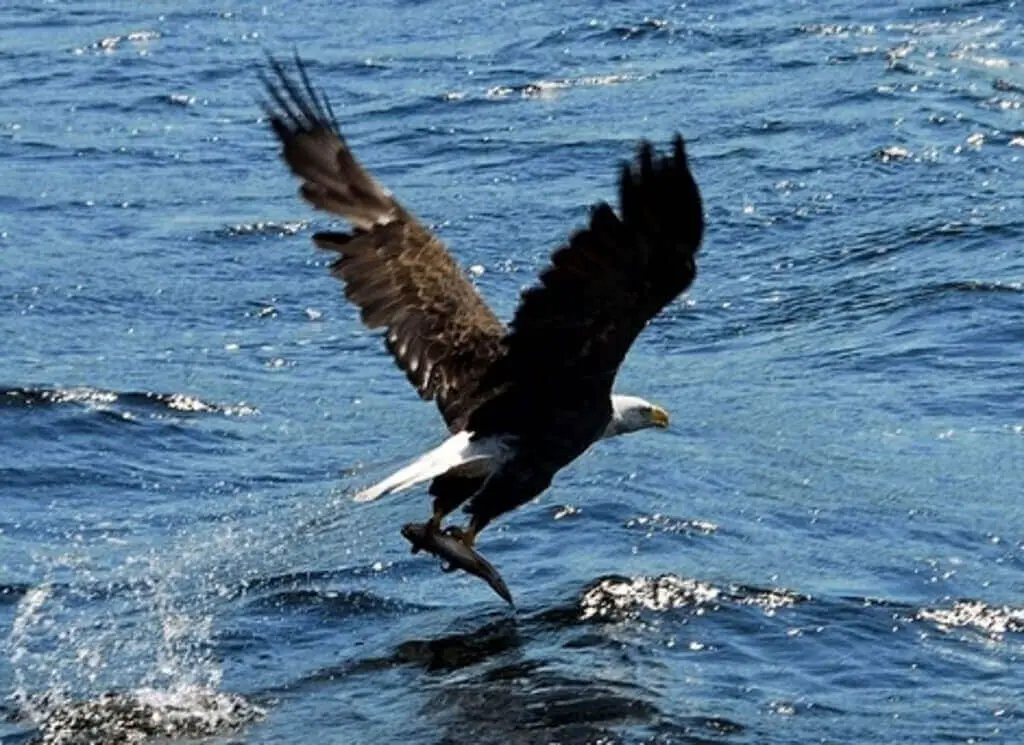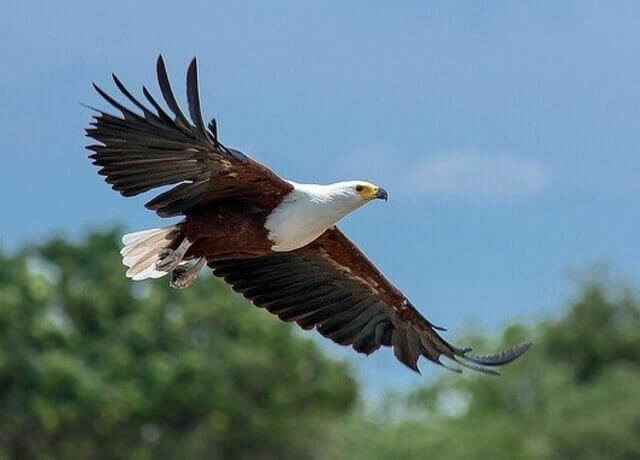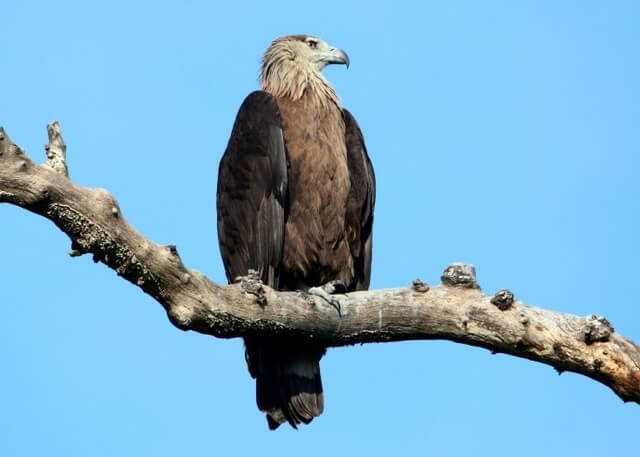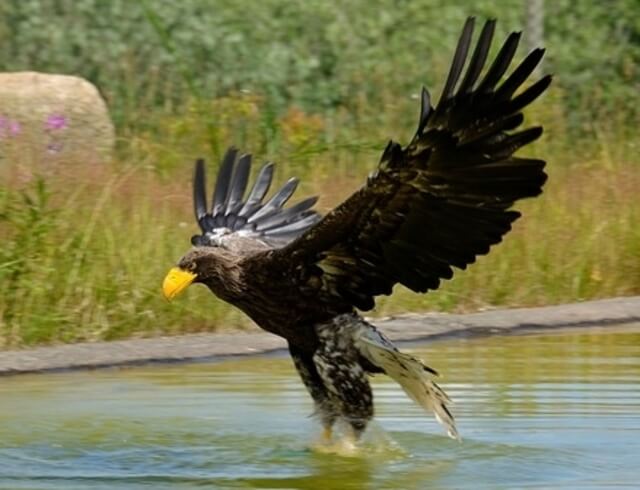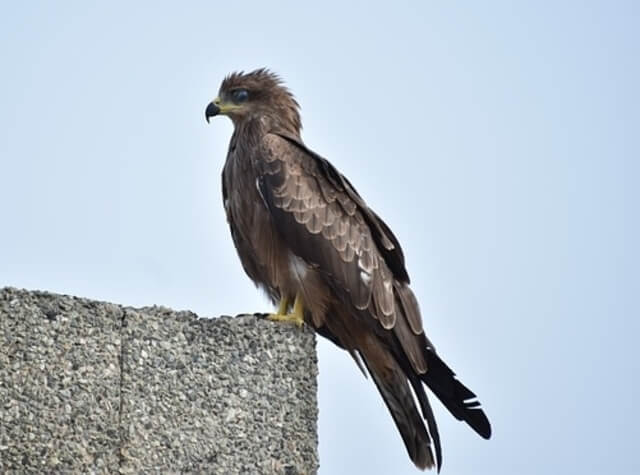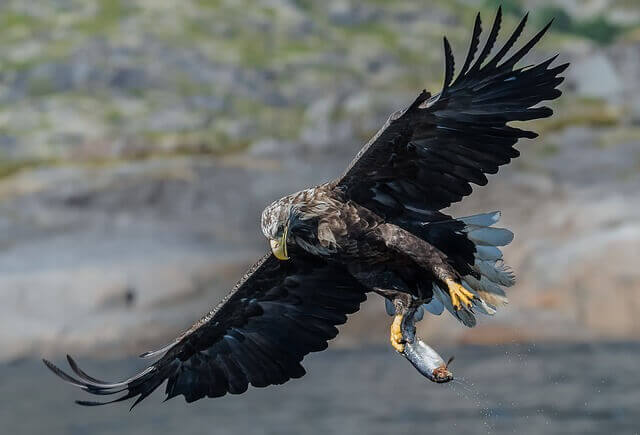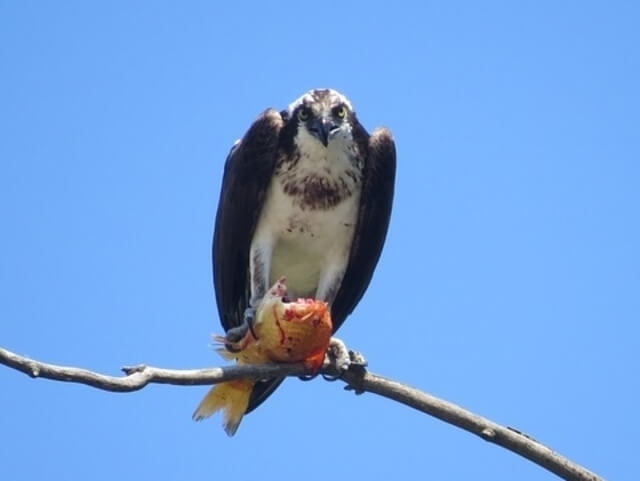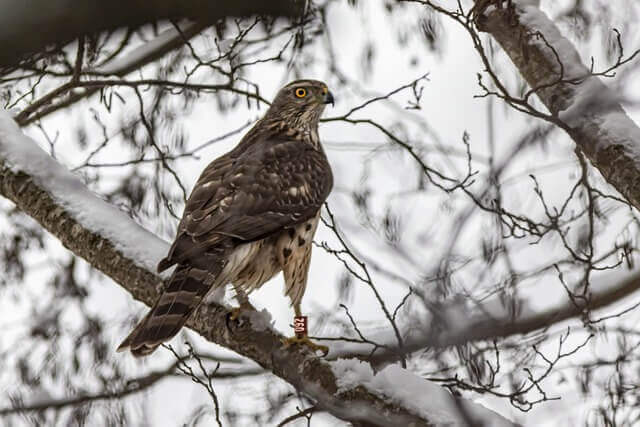In the avian world, some of the most impressive hunters are birds of prey, known for their remarkable hunting skills and keen eyesight. While many are known for their carnivorous diets, there exists a subset of these formidable creatures that have a particular affinity for fish.
In this exploration of the avian kingdom, we dive into the fascinating realm of birds of prey that specialize in capturing and feasting on fish. Join us as we discover these remarkable hunters and their unique adaptations for life near waterways.
Table of Contents
Bald Eagle
Bald Eagles are large birds of prey that eat fish as part of their diet. They mainly hunt fish in the water, but they will also feed on carrion if necessary. Bald Eagles are large birds with a wingspan up to 7 feet across and weigh 8-14 pounds when fully grown.
The bald eagle has been observed feeding on anything from crabs to ducks, however, its primary food source is live fish which it catches by swooping down at the surface and grabbing them with its talons.
- Length: 27.6-37.8″ in. (70-96 cm).
- Weight: 105.8-222.2 oz. (3000-6300 g).
- Wingspan: 78-80.5″ in. (198.1-204.5 cm).
- Range: North America, Central America and into northern South America.
- Habitat: Near freshwater sources or saltwater coasts, along the shoreline of estuaries and other wetlands, around inland lakes and reservoirs, on offshore islands without fresh water sources, coastal lagoons and bayous.
- Diet: Mainly of fish, but they will also eat birds, small mammals and carrion.
African Fish Eagle
African Fish Eagles are huge birds that prey on fish. They are skilled at diving for fish in rivers, lakes, or oceans. African Fish Eagles are found in Africa, mainly in the tropical rainforest regions south of the Sahara Desert, but they have also been seen in coastal areas near water sources.
The adult bird has a wingspan of up to six feet (1.8 meters) and feeds mostly on small fish like mullet or carp, which it captures by dive-bombing into the water from heights.
- Length: 29.5-33.5″ in. (75-85 cm).
- Weight: 70.0-88.2 oz. (1985-2500 g).
- Wingspan: 67.0-79.0″ in. (170.2-200.7 cm).
- Range: US and Canada, with isolated populations in Central America, South America and Asia.
- Habitat: Coastal wetlands, desert areas, grasslands, forests and mountainsides.
- Diet: Mainly of fish such as herring or smelt, but they will also eat other animals such as snakes or lizards
Gray-headed Fish Eagle
The Gray-headed Fish Eagle is a large bird of prey found in Eastern Asia. The eagle prefers freshwater habitats with plenty of vegetation and an abundance of fish, small animals such as frogs, rodents, and other birds. It hunts by watching from a high perch until it spots its prey below.
Then the eagle swoops down to capture the animal with its talons or to grab it in its large beak. The bird will then fly back up into a tree, where it can eat at leisure without fear of being disturbed by any other creatures on the ground.
- Length: 24-29.5″ in. (61-75 cm).
- Weight: 56.5-95.5 oz. (1601.7-2707.3 g).
- Wingspan: 60-67.0″ in. (152.4-170.2 cm).
- Range: Broad range across Asia including all of China, Mongolia, Russia, and parts of Africa.
- Habitat: Open grasslands to mountain forests, but prefers locations near water sources such as lakes or rivers.
- Diet: Mainly of fish, but it will also eat waterfowl, small mammals such as rabbits or mice, reptiles such as snakes or lizards, birds including seagulls or ducks.
Steller’s Sea Eagle
The Steller’s Sea Eagle, is one of the largest fish-eating raptors that can be found in lives in coastal regions of Russia, and the Aleutian Islands, as well as other parts of Eastern Asia. Roughly 80% of their diet is fish, such as salmon and trout, and the rest is waterbirds like geese, ducks, swans, gulls, herons.
This majestic creature has a wingspan of up to 7 feet! That means they can easily grab their prey out of the air or plunge into the water to catch their meal.
- Length: 34.0-42.0″ in. (86.4-106.8 cm).
- Weight: 218-335.1 oz.(6,195 to 9,500 g).
- Wingspan: 78.7-98.4″ in. (200-250 cm).
- Range: Pacific, North America and Eurasia.
- Habitat: Usually coastal regions near the ocean or inland forested areas.
- Diet: Salmon, sea urchins, eels, squid, crabs, and animals such as rabbits and water birds.
Indian Spotted Eagle
The Indian Spotted Eagle is a large bird of prey, found mainly in southern Asia, including parts of China, Thailand, Myanmar and India. Indian spotted eagles are mostly seen near wetlands, rivers, swamps and mangroves.
They feed on other birds like crows, quails and pigeons; reptiles such as snakes; mammals like rats; insects like beetles; eggs from various waterfowls including ducks and coots; small fish like carp which they catch while soaring over water bodies.
- Length: 23–28.3″ in. (59–72 cm).
- Weight: 56.4-88.2 oz. (1599-2500 g).
- Wingspan: 61.8-70.9″ in. (157–180 cm).
- Range: Pakistan to Myanmar and Bangladesh with a patchy distribution across India and Sri Lanka.
- Habitat: Woodlands and scrub forests near water sources.
- Diet: Fish such as carp, small mammals, birds and reptiles.
White-tailed Eagle
The White-tailed Eagle is the largest bird of prey in North America. It has a wingspan that can reach 7 feet and can weigh up to 14 pounds. The white-tailed eagle’s habitat ranges from Canada to Mexico, with nesting grounds primarily in Alaska, Idaho, Montana and Oregon.
They are also found in Europe and Asia. Their diet consists mainly of fish, which they are able to catch because their powerful talons are well adapted for catching fish out of the water or on land.
- Length: 26 to 37.4″ in. (66 to 95 cm).
- Weight: 141.5-180.5 oz. (4011.5-5117.0 g).
- Wingspan: 70.1-96.5″ in. (178.1-245.1 cm).
- Range: Europe, North America and parts of Asia.
- Habitat: Coastal areas to mountainous regions, where it nests on cliffs or trees near water sources.
- Diet: Mainly of fish, mammals, reptiles and birds.
Red-tailed Hawk
The Red-tailed hawk is a bird of prey found throughout North America and has been introduced to South America as well. It breeds from Canada to Central Mexico and can be found up to 2000 meters above sea level in the Rocky Mountains.
They live near water sources such as rivers, lakes or coasts because they eat fish and other aquatic animals that live there, as well as small mammals such as rodents, rabbits, squirrels and hares; however they will also eat birds (mostly pigeons), reptiles and insects.
- Length: 19.7-26.0″ in. (50-66 cm).
- Weight: 31.8-51.5 oz. (900-1460 g).
- Wingspan: 44.9-52.5″ in. (114-133.4 cm).
- Range: North America, Central America and northern South America.
- Habitat: Open country with scattered trees like fields or pastures, marshes and wet meadows.
- Diet: Fish, small mammals, reptiles, birds and large insects such as grasshoppers.
Red-shouldered Hawk
The Red-shouldered Hawk is a bird that lives in the Eastern United States. The red-shouldered hawk can be found throughout most of the Eastern US, excluding Florida and California. They are usually seen near woodlands, marshes, prairies and even suburbs with lots of trees.
This bird’s diet consists mainly of small mammals such as rabbits or squirrels, but they will also eat birds if there are any around to catch., and occasionally fish.
- Length: 16.8-24.2″ in. (42.7-61.5 cm.)
- Weight: 17.1-27.3 oz. (485-775 g).
- Wingspan: 37.0-44.1″ in. (94-112 cm).
- Range: Eastern United States from Florida to Canada along the Atlantic coast and Pacific coast respectively.
- Habitat: Forests, open country, coastal areas and swamps.
- Diet: Rodents, frogs, lizards, snakes, fish and insects.
Peregrine Falcon
The Peregrine Falcon, a remarkable migratory bird of prey, can be found across North America, Europe, and Asia, inhabiting diverse ecosystems spanning from Alaska to New Zealand. This avian species graces nearly all continents, excluding Antarctica. Peregrines exhibit a preference for rugged terrains, often residing in coastal cliffs or craggy mountainsides, where their prey thrives. These masterful hunters are known for their incredible speed, ranking as the fastest birds globally.
While they strategically dwell near water sources for fishing and hunting, they tend to avoid forested areas, favoring open landscapes. Their primary diet comprises other birds, showcasing their prowess as apex predators, but they won’t pass up the opportunity to dine on small mammals, reptiles, amphibians, and fish when available.
- Length: 13.8-19.7″ in. (35-50 cm).
- Weight: 18.6-56.4 oz (528-1600 g).
- Wingspan: 39.4-44.1″ in. (100-112 cm).
- Range: North America, Europe and Asia.
- Habitat: Mountains, grasslands, forests and wetlands.
- Diet: Small birds, but they also eat bats, small mammals, fish and insects if necessary.
Osprey
The Osprey, another magnificent bird of prey, boasts a widespread presence across North America, Europe, and Asia. Its range spans from Alaska to New Zealand, encompassing all continents except Antarctica. Ospreys exhibit a strong affinity for various landscapes, from coastal regions to inland water bodies, where they can indulge in their primary diet—fish. These raptors are renowned for their exceptional hunting skills and unique adaptations for catching aquatic prey.
Their nesting sites are often found near water bodies, and they construct large nests, known as eyries, typically on high structures like trees, utility poles, or artificial platforms. The Osprey’s striking appearance and impressive hunting prowess make it a remarkable species in the avian world, especially as a skilled fisherman of the skies.
- Length: 20.9-22.8 in (53-58 cm).
- Weight: 49.2-70.5 oz (1395-2000 g).
- Wingspan: 60.0-71.0 in (152.4-180.3 cm).
- Range: Most parts of Canada and the United States.
- Habitat: Rivers, lakes, coastal areas and other wetland habitats.
- Diet: Mainly fish, but will also feed on insects, small mammals and birds when needed.
Snowy Owl
The Snowy Owl, an iconic Arctic bird of prey, inhabits the frigid expanses of the Arctic tundra. These magnificent creatures are famed for their striking white plumage, which provides effective camouflage in their snowy surroundings. Snowy Owls are known for their exceptional adaptability to harsh winter conditions, with a range extending from the Arctic tundra to northern regions of North America and Eurasia.
They are predominantly daytime hunters, using their keen vision to spot and capture their prey, which primarily includes rodents like lemmings, as well as birds, squirrels and even fish. Despite their remote habitat, Snowy Owls occasionally migrate to more southerly locations, garnering attention and fascination wherever they go.
- Length: 20.5-28.3 in (52-72 cm).
- Weight: 56.4-104.4 oz (1600-2960 g).
- Wingspan: 49.2-57.1 in (125-145 cm).
- Range: Arctic regions of North America, Greenland, Iceland, Scandinavia and Siberia.
- Habitat: Open fields or marshes.
- Diet: Lemmings, hares, voles, ptarmigans and other small mammals like squirrels or groundhogs as well as fish such as trout and smelt.
Northern Goshawk
The Northern Goshawk, a formidable bird of prey, inhabits vast regions across North America, Europe, and Asia. Its range spans from Canada to northern Mexico, and it’s often found in various forested habitats, from coniferous to deciduous woodlands. These raptors are known for their remarkable hunting skills and agility, making them efficient predators.
Northern Goshawks primarily feed on a diet of birds such as robins, sapsuckers, crows, woodpeckers and mammals, often capturing their prey through surprise attacks while navigating dense forests with ease. Their adaptation to forested environments allows them to thrive in wooded landscapes, utilizing trees as vantage points and cover during hunts.
- Length: 20.9-25.6 in (53-65 cm).
- Weight: 22.3-48.1 oz (631-1365 g).
- Wingspan: 40.2-46.1 in (102-117 cm).
- Range: Canada and the northern United States, but also in the highlands of Mexico.
- Habitat: Forests, open country and near water sources.
- Diet: Rodents, snakes, lizards, rabbits, squirrels and occassionally fish.
Frequently Asked Questions
Which is a bird of prey that feeds on fish?
Osprey is a bird of prey that feeds on fish. They live all over the world except Antarctica and eat most types of fish, but they seem to prefer larger fish like trout or carp.
What bird eats big fish?
Sea eagles and ospreys are two of the most common types of birds that eat big fish. Ospreys typically feed on small to medium-sized fish, but have been observed catching a salmon as large as 8 pounds (3.6 kg). Sea eagles feed on various sizes of prey depending on what is available in their habitat.
Do hawks prey on fish?
Do hawks prey on fish? Yes, hawks our opportunistic hunters, and will occasionally hunt and eat fish. However, they prefer to hunt for other types of prey like mammals or reptiles. They usually feed on them when other food sources are scarce.
What birds eat fish out of ponds?
Many birds feed on fish out of ponds, and the majority of these are waterfowl. Waterfowl, herons, cranes, gulls, terns, kingfishers and cormorants hunt for fish in ponds. Herons and egrets will walk on the shore or edge of a pond looking for any movement that may indicate a fish. Cormorants dive underwater to catch their prey.
Does a heron eat mainly fish?
A heron is a type of bird that typically eats fish. This includes small, medium and large sized fish. However, they also eat frogs, snakes and insects. These are just some examples of what they may find in their diet on any given day.

